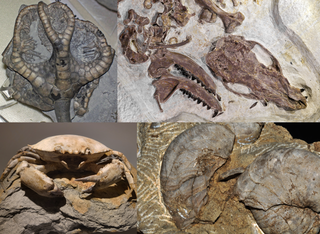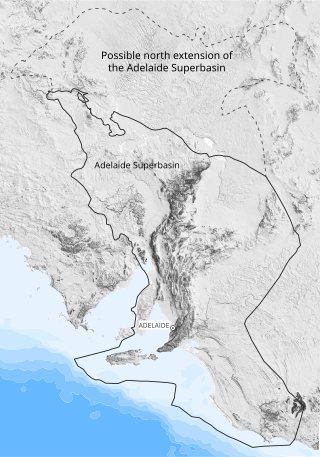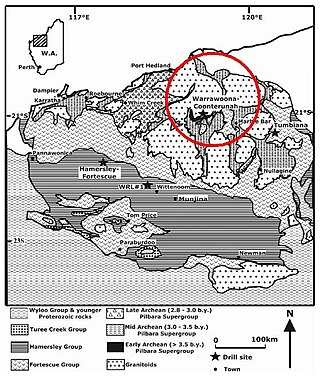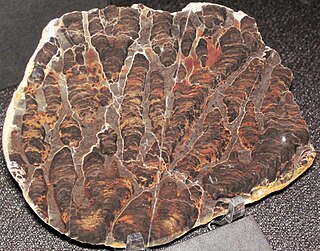
A fossil is any preserved remains, impression, or trace of any once-living thing from a past geological age. Examples include bones, shells, exoskeletons, stone imprints of animals or microbes, objects preserved in amber, hair, petrified wood and DNA remnants. The totality of fossils is known as the fossil record.

Stromatolites or stromatoliths are layered sedimentary formations (microbialite) that are created mainly by photosynthetic microorganisms such as cyanobacteria, sulfate-reducing bacteria, and Pseudomonadota. These microorganisms produce adhesive compounds that cement sand and other rocky materials to form mineral "microbial mats". In turn, these mats build up layer by layer, growing gradually over time.

A microfossil is a fossil that is generally between 0.001 mm and 1 mm in size, the visual study of which requires the use of light or electron microscopy. A fossil which can be studied with the naked eye or low-powered magnification, such as a hand lens, is referred to as a macrofossil.

Algal mats are one of many types of microbial mat that forms on the surface of water or rocks. They are typically composed of blue-green cyanobacteria and sediments. Formation occurs when alternating layers of blue-green bacteria and sediments are deposited or grow in place, creating dark-laminated layers. Stromatolites are prime examples of algal mats. Algal mats played an important role in the Great Oxidation Event on Earth some 2.3 billion years ago. Algal mats can become a significant ecological problem, if the mats grow so expansive or thick as to disrupt the other underwater marine life by blocking the sunlight or producing toxic chemicals.

The Adelaide Superbasin is a major Neoproterozoic to middle Cambrian geological province in central and south-east South Australia, western New South Wales, and western Victoria.

The Bitter Springs Group, also known as the Bitter Springs Formation is a Precambrian fossil locality in Australia, which preserves stromatolites and microorganisms in silica. Its preservational mode ceased in the late Neoproterozoic with the advent of silicifying organisms.

The Warrawoona Group is a geological unit in Western Australia containing putative fossils of cyanobacteria cells. Dated 3.465 Ga, these microstructures, found in Archean chert, are considered to be the oldest known geological record of life on Earth.
This timeline of natural history summarizes significant geological and biological events from the formation of the Earth to the arrival of modern humans. Times are listed in millions of years, or megaanni (Ma).

The Barberton Greenstone Belt of eastern South Africa contains some of the most widely accepted fossil evidence for Archean life. These cell-sized prokaryote fossils are seen in the Barberton fossil record in rocks as old as 3.5 billion years. The Barberton Greenstone Belt is an excellent place to study the Archean Earth due to exposed sedimentary and metasedimentary rocks.

Paleontology in Alaska refers to paleontological research occurring within or conducted by people from the U.S. state of Alaska. During the Late Precambrian, Alaska was covered by a shallow sea that was home to stromatolite-forming bacteria. Alaska remained submerged into the Paleozoic era and the sea came to be home to creatures including ammonites, brachiopods, and reef-forming corals. An island chain formed in the eastern part of the state. Alaska remained covered in seawater during the Triassic and Jurassic. Local wildlife included ammonites, belemnites, bony fish and ichthyosaurs. Alaska was a more terrestrial environment during the Cretaceous, with a rich flora and dinosaur fauna.

Kulpara is a rural town in South Australia, situated on the Copper Coast Highway and Upper Yorke Road in the Hummocks Range at the northern end of Yorke Peninsula.
Clonophycus is a genus of fossil microalgae. The type species, C. elegans, was found in the Barney Creek Formation, of the Middle Proterozoic of Northern Australia. The authors are uncertain if the microalgae are prokaryotic cyanobacteria or eukaryotic green or red algae.
Proaulopora is a Cambrian–Ordovician fossil genus of calcareous algae. It has been variously thought to belong to the green algae, red algae or cyanobacteria. It was originally established by the Russian paleontologist Aleksandr Grigoryevich Vologdin in 1937, for species known from the Lower Cambrian of the western Altai Mountains.

The evolution of bacteria has progressed over billions of years since the Precambrian time with their first major divergence from the archaeal/eukaryotic lineage roughly 3.2-3.5 billion years ago. This was discovered through gene sequencing of bacterial nucleoids to reconstruct their phylogeny. Furthermore, evidence of permineralized microfossils of early prokaryotes was also discovered in the Australian Apex Chert rocks, dating back roughly 3.5 billion years ago during the time period known as the Precambrian time. This suggests that an organism in of the phylum Thermotogota was the most recent common ancestor of modern bacteria.

Inzeria is a genus of fossil stromatolite-forming cyanobacteria from the late Riphean stage of the Neoproterozoic era. There are currently 9 accepted species.
Pilbaria is a genus of fossil stromatolite-forming cyanobacteria from the Paleoproterozoic era 2.3 to 1.7 billion years ago. It is named after the Pilbara region of Western Australia where the type specimen was found.
Linella is a genus of fossil stromatolite-forming cyanobacteria from the late Neoproterozoic era. There are currently 6 accepted species.
Jurusania is a genus of fossil stromatolite-forming cyanobacteria from the late Riphean to Vendian stages of the Neoproterozoic era.

Conophyton is a genus of stromatolite-forming cyanobacteria from the Neoproterozoic era. Fossils have been found in many countries, including Australia, India, China and Russia.












